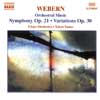Webern Orchestral Music
Yuasa and his Irish band meet Webern’s challenges with occasionally inspired success
View record and artist detailsRecord and Artist Details
Composer or Director: Anton Webern
Genre:
Orchestral
Label: Naxos
Magazine Review Date: 2/2002
Media Format: CD or Download
Media Runtime: 52
Mastering:
Stereo
DDD
Catalogue Number: 8 554841

Tracks:
| Composition | Artist Credit |
|---|---|
| Passacaglia |
Anton Webern, Composer
Anton Webern, Composer Takuo Yuasa, Conductor Ulster Orchestra |
| (5) Pieces |
Anton Webern, Composer
Anton Webern, Composer Takuo Yuasa, Conductor Ulster Orchestra |
| (6) Pieces |
Anton Webern, Composer
Anton Webern, Composer Takuo Yuasa, Conductor Ulster Orchestra |
| Symphony |
Anton Webern, Composer
Anton Webern, Composer Takuo Yuasa, Conductor Ulster Orchestra |
| Variations |
Anton Webern, Composer
Anton Webern, Composer Takuo Yuasa, Conductor Ulster Orchestra |
Author:
Fiftytwo minutes is all it takes to cover Webern’s orchestral music‚ at least if the early tonepoem Im Sommerwind and the Concerto for Nine Instruments – virtually chamber music‚ but needing a conductor – are excluded. Yet the prevailing brevity is deceptive. The journey from the Passacaglia (1908)‚ where Webern’s instinct for compression and his inherited lateRomantic expansiveness come into conflict‚ and on to the radically concentrated‚ potently expressive Variations (1940)‚ remains one of the most farreaching in 20thcentury music. It’s very good to have it made available at superbudget price.
The best performances here are those of the Symphony and the Variations‚ in which Takuo Yuasa’s scrupulous balancing of constantly fluctuating textures and tempos doesn’t inhibit a natural sense of flow‚ nor a positive realisation of the music’s often surprisingly robust poetic essence. Even with sound lacking ideal warmth and tonal bloom‚ this account of Op 30 successfully delineates the imaginative orchestral sonorities – a brief tuba solo here‚ the delicate fabric of interacting lines for solo and tutti strings there. The earlier works are less convincing in style‚ though accurate in their attention to detail‚ while the sound balance seems to have been adjusted for Op 10’s muchreduced orchestration (just 17 players‚ including mandolin‚ guitar and harmonium) the playing has less presence than in Op 21 and Op 30‚ and the often nightmarish canvasses of Op 5 and Op 6 – the latter done in the scaleddown 1928 instrumentation – have less dramatic power than in the Boulez versions (Sony‚ 6/91; DG‚ 6/00).
In the stringorchestra arrangement of the Five Pieces for String Quartet too much seems dutiful‚ even cautious. But Op 1 has some fine wind and brass playing – those exposed high horn notes ring out clear and secure – and this score’s rather rickety structure hangs together as well as it ever can. In sum‚ reliable and at times inspired readings of music whose historical significance shouldn’t inhibit a keen appreciation of its character and depth.
Discover the world's largest classical music catalogue with Presto Music.

Gramophone Digital Club
- Digital Edition
- Digital Archive
- Reviews Database
- Full website access
From £8.75 / month
Subscribe
Gramophone Full Club
- Print Edition
- Digital Edition
- Digital Archive
- Reviews Database
- Full website access
From £11.00 / month
Subscribe
If you are a library, university or other organisation that would be interested in an institutional subscription to Gramophone please click here for further information.




